Hunting mushrooms is a favorite pastime of many people! Some of the mushrooms shown below are easy to find
in the nature center while others are quite difficult! If a mushroom is marked edible please do not eat it as there are many look-alike varieties that are deadly poison. It is better to leave the mushrooms for the local wildlife to enjoy.
Ear Jelly
Arucularia auricula
|
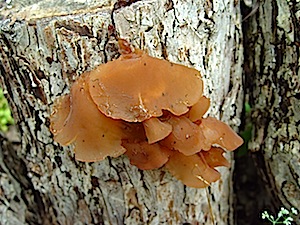
|
This mushroom is called Ear Jelly for obvious reasons. It loves to grow on the sides of trees and sometimes on the ground
if there is woody material available. It prefers hardwoods and will also grow on the sides of logs and fallen limbs. Unlike the coal fungus it ejects its spores directly from the soft and jelly-like surface.
Edible!
|
Turkey Tail
Polyporus versicolor
|
This is one of the common mushrooms found in the park. It is very woody and definitely not edible although it has been used to make a tea, in traditional medicine and to make green dyes. The Japanese are testing it to see if it can be used to reduce cancers. It forms colorful semicircular shelves on the sides of trees and the colors are often quite variable.
Not edible!
|
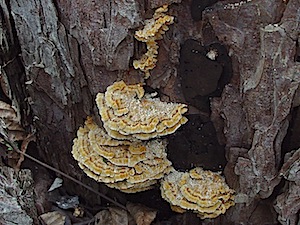
|
Hairy Bracket
Polyporus hirsutus
|
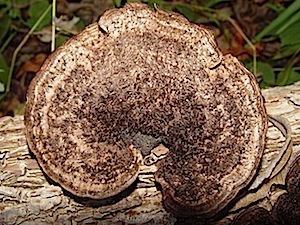
|
This giant mushroom can grow several inches in just a couple of weeks! The hairy surface develops from 2 to 5 weeks. It is one of the more common mushrooms in the park and can be easily recognized by its brown color and hairy surface. One often sees a dozen or more of these mushrooms growing on a single fallen tree. It grows on many types of dead wood and survives thanks to its tough composition.
Not edible!
|
Split Gill Mushroom
Schizophyllum commune
|
This small mushroom has a very interesting shape. On top it is white and quite spiny. Underneath it has gills that form interesting patterns (click on thumbnail). It is cap shaped and becomes rigid when dry. The gills also split when dry and thus the name "split gill". When it gets wet its gills actually move, one of the few mushrooms that can do this! It is rubbery and thus not popular as food in the US and Europe. It is a very popular food in the tropics.
Edible!
|
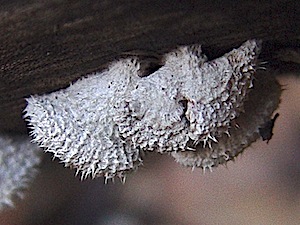
|
Small Stagshorn
Calocera cornea
|
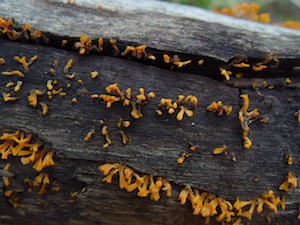
|
This jelly mushroom loves to grow on moist decaying wood. It can form thick mats of up to one inch thick on oaks and other hardwoods after a good rain. Each bright yellow-orange fruiting body is a jelly-like finger and has no distinct cap.
Not edible!
|
Fungus Volcano
Fusicolla merismoides
|
This bright orange fungus is one of the stranger mushrooms as it actually made up of several different fungi. In our area it is often seen slowly growing on the outside of grapevine stems. It is an indicator that the grapevine is actually damaged in some way and the mushroom is taking advantage of this to get some desirable (for it) nutrients. It is not known whether it is edible so it should certainly NOT be eaten.
It is known by several names including ”Fungus Volcano” and ”Deer Vomit”. Do not blame deer for this mushroom!
Unknown!
|
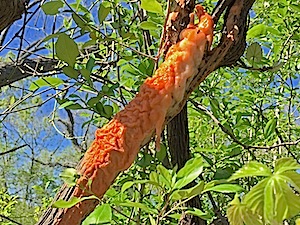
|
Coal Fungus
Daldinia concentrica
|

|
This tough shelled mushroom looks and feels quite dead but it is very much alive! If you slice it down the middle you will see concentric growth rings that occur every season. At the surface it has tiny tubes from which water pressure shoots the spores into the air so that they can spread. This mushroom softens and breaks down the wood so that it can provide nutrients in the soil for other plants and animals.
It is not edible!
|
Common Tarcrust
Diatrype stigma
|
This mushroom is perhaps one of the easiest of all to identify. Just find a standing or fallen tree that looks like someone tried to set on fire. When mature it is a black or brown tar-like coating on the surface of the tree trunks. When young the surface is very bumpy with spores being prepared to be ejected like a small volcano from each bump. When mature the surface becomes fairly smooth. This fungus is harmless to trees as it only grows on dead wood.
Not Edible!
|
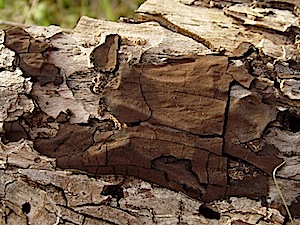
|
Oyster Mushroom
Pleurotus ostraetus
|
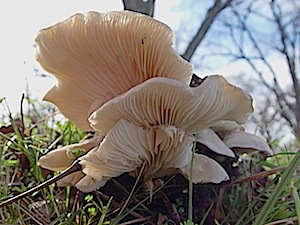
|
This is perhaps the most beautiful mushroom that is found in the park! It is white and can grow to nearly a foot in diameter and is usually found growing on dead or dying trees feeding on the dead wood but not harming the tree itself. This mushroom is particularly interesting because it is carnivorous and feeds on small roundworms! It probably gets its nitrogen nutrients in this way. Finally, the oyster mushroom is cultivated worldwide as a delicacy in foods although mature mushrooms become acrid and unpleasant to eat.
Edible!
|
Dead-man's Fingers
Xylaria polymorpha
|
This odd looking mushroom was found growing in the nature trail area. It is a sac mushroom that is often dark gray or cream colored, darkening over the summer as it ages. It can take many forms and thus the name "polymorpha". It has a fairly tough exterior filled with tiny holes. These two fruiting bodies are competing with the black Common Tar-crust mushroom covering much of this fallen log. The name "Dead-man's Fingers" is applied to all of the species in the genus Xylaria as they all resemble pointing fingers growing on dead wood.
Not Edible!
|
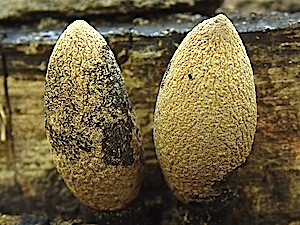
|
Pear-shaped Puffball
Lycoperdon pyriforme
|

|
These cute small light brown mushrooms are fairly easily identifiable as they often grow in large clusters and as they are puffballs the mature fruits can emit spores when squeezed, stepped upon, brushed by animals or rained upon. Beware not to breath in the spores as this can cause severe respiratory problems! They grow on wood and so are often found growing in hollow logs, on dead logs and on the forest floor if there is sufficient rotting woody material. Extreme caution should be taken before eating these as they look similar to three different types of Death Angels, the Amanitas. They also can only be eaten when young and solid white inside and out. If you see a primitive mushroom inside then this is not a puffball mushroom and likely highly poisonous.
Edible only when young!
|
White Maze Polypora
Trametes elegans
|
This weird mushroom was found growing on a pecan tree stump in the camping area. It is strange because it decide whether to make nice round pores or long narrow grooves. On top it is white and lumpy with a tough exterior. On bottom it is very interesting looking with pores that can be long and thin to nearly circular. Click on the thumbnail to see this. It is harmless to trees as spends it life consuming dead wood and can grow in size to more than 1 foot across. It is one of the more common mushrooms in the eastern USA.
Inedible!
|
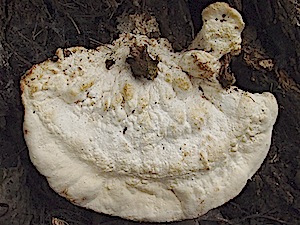
|
"Mountain Cedar" Fungus
Robergea albicedrae
|
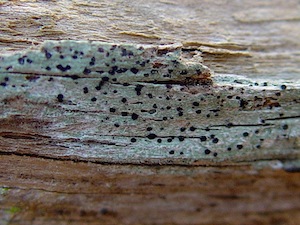
|
This mushroom is particularly interesting because it is by far the most common mushroom you will see in any area containing living Mountain Cedars (aka Ashe Junipers). It is not unusual, when seeing this fungus, to think that someone has painted white patches on the trunks and limbs of the cedars! This particular example was actually a very lucky find because the mushrooms are normally quite difficult to see as they are usually small grey spots on a white background. Here they are just the right age to show up as black spots! The spots correspond to the fruiting bodies and the white areas are the supporting "roots" (Mycelia). The "roots" harvest nutrients from the living tree and are not completely harmless. Although they will not kill the tree they will probably slow down its growth a bit.
Not edible!
|
Straight Stalked Entoloma
Entoloma strictius
|
This delicate small mushroom has one of the more interesting shapes of the many toadstool shapes. It has very large and pink fleshy colored gills, an upturned outer edge, a very thin and straight stalk and often has wavy edges when mature. It was found growing all by itself in full sunlight in the middle of a mowed strip of grass.
Poisonous, do not eat!
|
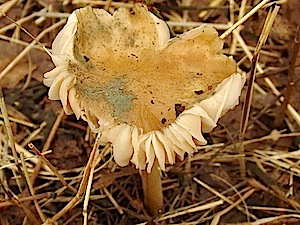
|
"Spring Polypore" Fungus
Polypora aricularius
|
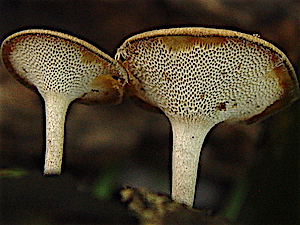
|
This small funnel shaped mushroom is often found by Morel hunters. It will be found growing in shady areas with lots of dead hardwood trunks that are
severely rotted. Pecan logs seem to be the preferred hardwood at Berry Springs. Look for the brown to tan cap with a dimple on top in the middle within a day or two after a good
rain. Check to see if the underside has
lots of roughly rectangular pore openings. The spores travel down the tube and exit through the openings. Next, check to see if the outer
edge has lots of hairs. If it has dried out a bit the outer lip curls under and the hairs will be hard to see. It is tough and should
not be eaten!
Not edible!
|
|
Note: The author is not an expert on mushroom identifications and has made a best effort to properly identify these specimens. As a result it is possible that some of these may not be properly identified. - C. Newsom
|














